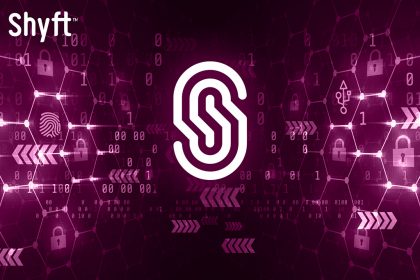[ad_1]
Shyft Network will bridge this gap to facilitate institutional adoption of blockchain-based solutions through its opt-in infrastructure.
Blockchain-based identity verification network Shyft Network has unveiled its native cryptocurrency, the SHFT token together with its planned use case. The news comes as a timely reminder of the network’s relentless effort to provide an ideal platform for reclaiming trust, identity, and credibility for humanity.
SHFT Token
The SHFT token, being the native cryptocurrency, will be used as the only acceptable means of payment for security and operations on the Shyft Network. The token will also be used to facilitate transactions between intermediaries using different identity systems. This will substantially boost efficiency in the data markets by enabling a frictionless payment mechanism for operators on different blockchain networks. The SHFT token payment gateway will also enable collaboration between centralized and decentralized systems by serving as a neutral by on-ramp that is easily compatible with multiple protocols and network architectures.
Besides this core purpose, the SHFT token will serve as a multifunctional cryptocurrency that users can deploy to unlock various use cases. Describing this attribute, part of the announcement post stated:
“SHFT is a means of payment, a mechanism for bonding value, and an instrument for governance value capture. SHFT, depending on the use case, can be utilized in a multitude of ways which includes a monetary instrument and value capture system, as well as an authorization system for long-term validation.”
The SHFT currency will also serve other purposes on the platform like governance. Considering that the Shyft Network is an opt-in protocol, there is a need for well laid out systems that enable all players to interact in a trustless environment. In this regard, SHFT will be the foundation of the Shyft Network governance mechanism to support coordination across multiple ecosystems. This is expected to in turn enable entity-to-entity governance, compliant asset creation, and a system for compliant DeFi.
By facilitating such transparent collaboration between various players, the SHFT token will completely open the existing ecosystem to multiple new possibilities. It has the potential to significantly increase the number of participants in the network from across the board whether centralized or decentralized protocols, applications, and marketplaces.
Case for SHFT Token
The crypto space has evolved drastically over the past decade, making major strides in the journey towards mass adoption. Despite having achieved this huge progress, the industry is still struggling with issues of trust, transparency and credibility. Understandably, the decentralization movement is founded on trustlessness, permissionless participation and censorship proof. For so long, these core tenets have been at the forefront of the movement, serving as the guiding light. But, as decentralized systems edge closer to the mainstream, they are turning out to be stumbling blocks on the path to mass adoption.
As things stand, the crypto movement is at a point of inflection with the tide capable of turning either way, especially as institutions interest in the space is soaring.
The Shyft Network believes that identity is the primary factor that will determine how the tide will turn next and the direction that decentralized systems take onwards. They believe that for the blockchain industry to move forward and continue its progress towards the mainstream markets there is a need to create identity systems. As such, they are focused on developing mechanisms for identity and reputation verification aimed at not only reclaiming but also reaffirming trust in decentralized systems.
Shyft Network is Bridging Gap for Institutions
The Shyft Network identity verification network will unlock the true potential of decentralized systems by providing a platform for users and entities to create and coordinate more freely. The protocol introduces a new degree of transparency whereby players willingly provide their identification details for verification. Therefore, participants can know the person or organization behind the verified addresses.
The data will be securely stored on the Shyft blockchain and will only be shared with other participants under the owner’s consent. Shyft Network believes that this simplistic and forthright credential verification protocol will form the base layer for collaboration between users, institutions, Dapps, DeFi, and other parties on the platform.
The SHFT currency is used to ensure spam prevention, prevent data attacks against exchanges and global users of the system, create payment and bonded asset channels for untrusted counterparties (a form of data market transaction) and over the long term helps maintain the governance system currently being directed and developed by the global coalition of digital asset companies.
One of the most important roles of the Shyft Network is bridging the gap for mainstream institutions to join the decentralized systems. Usually, these organizations operate under a highly regulated environment with stringent compliance requirements. As such, they have been reluctant to join the crypto ecosystem as its unregulated nature poses numerous compliance challenges.
Shyft Network will bridge this gap to facilitate institutional adoption of blockchain-based solutions through its opt-in infrastructure. Their protocol will enable such regulated organizations to implement their rules on the decentralized network, effectively granting them access to some exciting systems like DeFi. In turn, the crypto ecosystem will benefit from increased liquidity and mass onboarding of these institutions’ customers.
Considering that the SHFT token will fuel the Shyft Network data market ecosystem, its unveiling is a major stride towards the mainstream adoption of cryptocurrency. The token not only unlocks the protocol’s economy but also opens up the crypto space to new use cases and bridges the gap towards a cross-protocol ecosystem.
next

Having obtained a diploma in Intercultural Communication, Julia continued her studies taking a Master’s degree in Economics and Management. Becoming captured by innovative technologies, Julia turned passionate about exploring emerging techs believing in their ability to transform all spheres of our life.
[ad_2]
Source link



